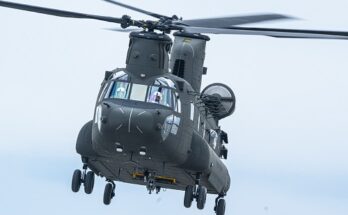
The U.S. Missile Defense Agency has awarded Lockheed Martin Rotary and Mission Systems of Moorestown, New Jersey, an undefinitized contract action (UCA) for the future AEGIS Guam System. The announcement was made by the U.S. Department of Defense on December 28. The contract, with a not-to-exceed value of $527.7 million when inclusive of all options, was awarded as a sole-source, hybrid (cost-plus-incentive-fee and cost-plus-fixed-fee) modification (P00054) to previously awarded contract HQ0851-21-C-0002. The award increases the total value of the base contract from $811.6 million to $1,237.0 million.
The Department of Defense stated that when implemented, the UCA would expand performance of the AEGIS Weapon System by incorporating Integrated Air and Missile Defense (IAMD) capabilities into the AEGIS Guam System.
Although the terminology referring to a potential air and missile defense installation in Guam has shifted around in recent years, Forecast International believes this award is in support of a long-gestating BMD capability requirement that is now most commonly referred to as the Homeland Defense Radar – Guam, or HDR-G.
In some ways, the HDR-G could be seen as having its roots in a now-canceled program known as the Pacific Discriminating Radar (PDR). The PDR was originally envisioned as a Pacific Ocean-based next-generation missile defense capability enhancer alongside the Long-Range Discrimination Radar (LRDR) installed at Clear Space Force Station, Alaska, but support for the PDR eventually waned, and, according to the Department of Defense FY21 Budget Estimates released in February 2020, the MDA ceased requesting forward funding for the program.
Unlike all AEGIS Ashore facilities constructed to date, which have utilized the venerable SPY-1 radar, the iteration in Guam would utilize Lockheed Martin’s next-generation AEGIS radar, the SPY-7. The SPY-7, it should be noted, is itself derived from Lockheed Martin’s work on the aforementioned LRDR. Collectively, Lockheed Martin has sometimes referred to these radars as the Solid State Radar (SSR) Family.
The proposed AEGIS Ashore location on Guam, or HDR-G, was at one time envisioned as utilizing a four SPY-7 array-paneled configuration, making it capable of 360° detection. It is possible that the arrays could be upscaled from the version that Lockheed Martin unsuccessfully proposed for Flight III Arleigh Burke class destroyers, since the SPY-7’s “arrays” are in actuality a composite of a number of modular sub-array panels. A larger array panel of panels, so to speak, would provide the facility with longer-ranged detection and increased locating resolution. At this time, Forecast International is uncertain of how many arrays will be included in the HDR-G’s final configuration or of their sizing.
Japan, under a U.S. Foreign Military Sales (FMS) effort, provided Lockheed Martin with the preliminary rounds of funding for the creation of a SPY-7-compatible AEGIS Ashore. The country had plans to install two SPY-7-equipped AEGIS Ashores, but eventually ran into issues with spiraling funding requirements and plummeting support from the public.
The Japanese AEGIS Ashores were canceled, but the services and equipment that had been funded in support of the land-based AEGIS systems were eventually reimagined and were reconfigured for two sea-based AEGIS vessels. Japanese funding for a SPY-7-based AEGIS capability continues.
For the purpose of the recently announced award, the MDA is obligating an initial round of $11.4 million in Fiscal Year 2023 research, development, test, and evaluation funding at time of the award.
Lockheed Martin’s work will be performed in Moorestown, with period of performance lasting from the time of the award (December 28, 2023) through December 31, 2027.
The U.S. Missile Defense Agency at Dahlgren, Virginia, is performing the role of contracting activity for the program.
Forecast International provides its expansive range of corporate and governmental customers with one of the most comprehensive portfolios of aerospace and defense industry forecasts and program reports available. For more information on the SPY-7, LRDR, other radars, or any other aerospace and defense industry programs, contact a sales representative today. For access to historical and extended 15-year forecasts, ask about the Platinum Forecast System.
In his role as a Senior Defense Electronics Analyst at Forecast International, C. Zachary Hofer's studies focus primarily on air, land, and sea radar systems, as well as the airborne electronics segment.


